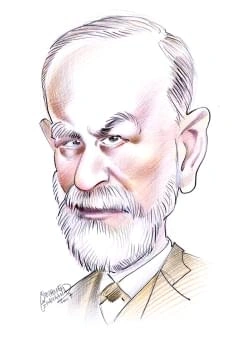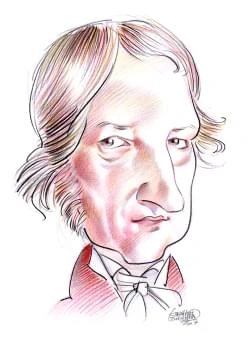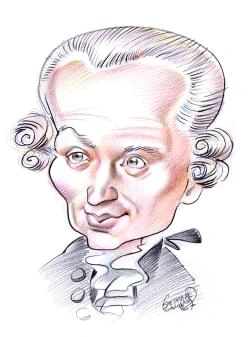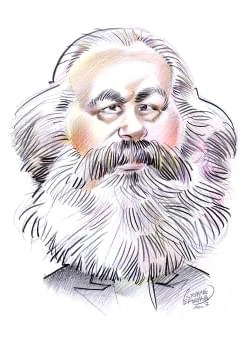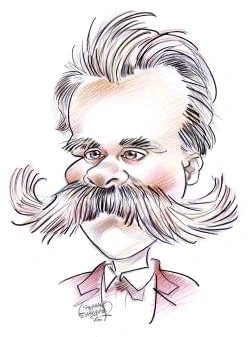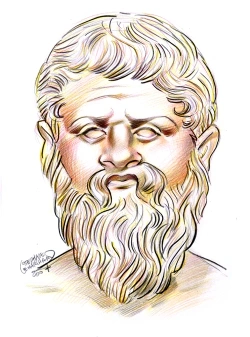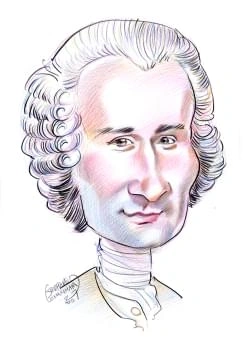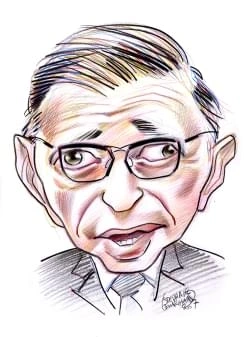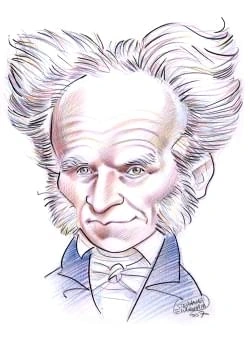18 résultats pour "row"
- Schoolcraft, Henry Rowe Schoolcraft, Henry Rowe (1793-1864), explorateur et ethnologue américain.
- VIOLENCES A PARK ROW
-
Greek Art and Architecture - USA History.
The struggle between these two city-states and their allies ultimately led to the Peloponnesian War (431-404 BC), which Sparta won. Despite this conflict, the 5th century, often called the Classical period, is usually considered the culmination of Greek art, architecture, and drama, with its highest achievements being the Temple ofZeus at Olympia, the Parthenon in Athens, and the plays of Athenian dramatists Aeschylus, Sophocles, Euripides, and Aristophanes. The 4th century, or Late Classical p...
- BELLE PÉNITENTE (La) (résumé & analyse) Nicholas Rowe
-
Arithmetic
I
INTRODUCTION
Arithmetic, branch of mathematics that arises from counting, the most basic mathematical operation.
Subtract the units: 6 - 3 = 3. Then subtract the tens column: 6 – 2 = 4. The results of these two single-digit subtractions, written side by side, provide the answer: Subtraction is a bit more complicated if we need to subtract a larger digit from a smaller one. For example, when subtracting 47 from 92, the units value (7) of 47 isgreater than the units value (2) of 92. We can handle this situation using a procedure called borrowing, which is like carrying in reverse. Ten units can be borrowe...
-
House (architecture)
I
INTRODUCTION
Trulli in Alberobello, Italy
Alberobello, in the Apulia region of southeastern Italy, is noted for its unusual limestone houses known as trulli (from
Greek trullos, dome).
Fresco in the Villa of the Mysteries, PompeiiThe Villa of the Mysteries, Pompeii, Italy (built about 50 bc), featured a large hall with this mural encircling it. The mural ispainted in the Second Style of Roman painting. (Historians of art recognize four periods or styles in Roman wall painting.)The mural in the Villa of the Mysteries is thought to depict the initiation rituals of a mystery religion. For this reason, it hasbeen conjectured that the hall was used for cult rituals.Bridgeman Art Li...
-
Grasses - biology.
This, together with details of overall structure and less easily observed characteristics of anatomy, cytology, and chemistry, accounts for the tremendous number ofspecies of grasses. VI OTHER GRASSLIKE PLANTS Plants of two other groups, the sedges and the rushes, are superficially similar to grasses and are often confused with them. The three groups are easily distinguished,however, by examining their flowers, stems, and leaves. Rushes have flowers with six-part perianths (floral whorls) and...
-
Nashville - geography.
May event has grown into a major festival. In September the city hosts the Tennessee State Fair. One of Nashville's principle attractions is Opryland, a complex of entertainment and broadcasting facilities that offers live music shows, a resort and convention center,and shopping outlets. Since 1974 it has been the home to the Grand Ole Opry radio show, a country-music production that has not missed a broadcast since 1925. Percy Park and Edwin Warner Park provide open space, trails, playing field...
-
-
Greek Art and Architecture - history.
powerful independent city-states. From 334 to 323 BC, Alexander the Great extended his father's empire into Asia Minor (now Turkey), Syria, Egypt, Persia, Afghanistan, and as far as India. D The Hellenistic Period (323-31 BC) Although Alexander the Great extended Greek civilization far beyond the Greek mainland and the boundaries of the Aegean Sea, his empire did not survive his death in 323.After Alexander died, his generals and successors divided the empire into a number of kingdoms: Ptolem...
-
HEAVY BOOTS
HEAVIER BOOTS
Twelve weekends later was the first performance of Hamlet, although it was actually an abbreviated modern version,
because the real Hamlet is too long and confusing, and most of the kids in my class have ADD.
HEAVIER BOOTS Twelve weekends laterwasthefirst performance of Hamlet, although itwas actually anabbreviated modernversion, because thereal Hamlet is too long andconfusing, andmost ofthe kids inmy class have ADD. Forexample, thefamous "To beornot tobe" speech, whichIknow about fromthe Collected Shakespeare set Grandma boughtme,was cutdown so that itwas just, "Tobeornot tobe, that's thequestion." Everyone hadtohave apart, butthere weren't enoughrealparts, andIdidn't gotothe auditions becausemyboot...
-
Teeth.
treatments to reduce the risk of tooth decay; clear plastic coatings painted on the teeth, called dental sealants, and applications of the mineral fluoride, which fortifiestooth enamel, are two such treatments. Fluoride is also added to public water supplies in a process called fluoridation, which benefits more than 150 million Americans. Gum disease, or periodontal disease, is a progressive condition that worsens with age. Gum disease occurs when bacteria eat away at gum tissue, causing it to p...
-
Latin American Music
I
INTRODUCTION
Tito Puente Playing the Drums
Since the 1950s American drummer Tito Puente has popularized Latin American music, especially the mambo, in the
United States.
Panpipe Music of BoliviaWell before the Spanish conquest, native peoples such as the Quechua and Aymara living in the Andes Mountains inBolivia, Peru, and Ecuador, developed a rich musical tradition. Panpipes (set of tuned pipes), made of ceramic, sugarcane,or bone were paired with shell trumpets, cane flutes, and drums, which accompanied dancers during religious and secularceremonies. Large ensembles of 4 to 20 panpipe players are still the norm, and Spanish influences have since beenintegrated...
-
Industrial Revolution
I
INTRODUCTION
Industrial Revolution, widespread replacement of manual labor by machines that began in Britain in the 18th century and is still continuing in some parts of the world.
The most important advance in iron production occurred in 1784 when Englishman Henry Cort invented new techniques for rolling raw iron, a finishing process thatshapes iron into the desired size and form. These advances in metalworking were an important part of industrialization. They enabled iron, which was relativelyinexpensive and abundant, to be used in many new ways, such as building heavy machinery. Iron was well suited for heavy machinery because of its strength anddurability. Because of t...
-
Industrial Revolution .
The most important advance in iron production occurred in 1784 when Englishman Henry Cort invented new techniques for rolling raw iron, a finishing process thatshapes iron into the desired size and form. These advances in metalworking were an important part of industrialization. They enabled iron, which was relativelyinexpensive and abundant, to be used in many new ways, such as building heavy machinery. Iron was well suited for heavy machinery because of its strength anddurability. Because of t...
- Determinant.
-
Matrix Theory and Linear Algebra
I
INTRODUCTION
Matrix Theory and Linear Algebra, interconnected branches of mathematics that serve as fundamental tools in pure and applied mathematics and are becoming
increasingly important in the physical, biological, and social sciences.
vectors and V is called a vector space of dimension m. Two- and three-dimensional Euclidean spaces are vector spaces when their points are regarded as specified by ordered pairs or triples of real numbers. Matrices may be used to describe linear changes from one vector space into another. Contributed By:James Singer Reviewed By:J. Lennart BerggrenMicrosoft ® Encarta ® 2009. © 1993-2008 Microsoft Corporation. All rights reserved.
-
-
Native American Art.
folding, braiding or weaving, could also be sewn onto the hide. The production of decorated clothing and bags increased after contact with Europeans as a greater variety of textiles and other materials became available throughtrade. Imported glass beads inspired native women, who quickly adapted quillwork techniques for the creation of beaded apparel. European curvilinear and floraldesigns of the 19th century proved as meaningful for the native women who worked with them as they were for the non...
-
London (England) - geography.
In the northern part of the West End is Bloomsbury, the city’s traditional intellectual center, with its concentration of bookshops and homes of writers and academics. Inthe early 20th century a number of famous writers, critics, and artists who lived here became known as the Bloomsbury Group. Here, too, is the British Museum, one ofLondon’s chief tourist attractions. Nearby is the giant complex of the University of London, whose various colleges and departments have taken over much ofBloomsbury...
}})
